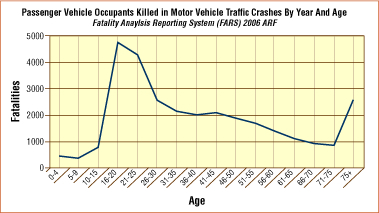|

Priority Program Areas
NHTSA is focusing its effort in three priority areas to prevent motor-vehicle-related fatalities and injuries for teens:
Access to Alcohol • Graduated Driver Licensing (GDL) • Seat Belt Use
Access to Alcohol
Teens are at far greater risk of death in an alcohol-related crash than the overall population, despite the fact that they are below the minimum drinking age in every State. Among 15- to 20-year-old drivers involved in fatal crashes in 2006, 31 percent of the drivers who were killed had been drinking and 77 percent of these drivers were unrestrained. High-visibility enforcement of underage purchase, possession, and provision laws can create a significant deterrent for violation of youth access laws, reduce consumption, and decrease alcohol-related crash involvement.
NHTSA’s core strategies for reducing youth access to alcohol include:
- Actions directed at adults, such as media messages on parent and other adult responsibility, keg registration laws, and enforcement of laws against purchasing alcohol for youth;
- Actions directed at youth, such as tamper-proof licenses, “use-and-lose” laws that confiscate the drivers license of underage drinkers, law enforcement party patrols, and peer education;
- Actions directed at alcohol vendors (e.g., point-of-sale training and compliance checks); and
- Comprehensive community programs that bring together community groups and agencies.
Graduated Driver Licensing (GDL)
Young, novice drivers are significantly over represented in fatal crashes, particularly 16- and 17-year-old drivers. Immaturity and inexperience are primary factors contributing to fatal crashes by young drivers. Three-stage GDL laws address these factors by reducing high-risk exposure for novice drivers. Evaluations clearly show the benefits of adopting GDL laws, generally indicating 20- to 50-percent reductions in crashes of young novice drivers.
NHTSA’s core strategies for strengthening GDL laws include:
- Enactment of three-stage GDL legislation containing NHTSA -recommended components;
- Highly publicized enforcement of GDL laws; and
- Increasing parental responsibility in monitoring novice driver compliance with GDL laws.
Seat Belt Use
Teens have lower seat belt use rates than adults. Despite efforts aimed at increasing belt use in this age group, observed use among teens and young adults (16 to 24 years old) in 2008 was the lowest of any age group at 80 percent. In fatal motor-vehicle crashes, the majority of teens (16 to 20 years old) continue to be unbuckled (56% in 2009).
NHTSA’s core strategies for increasing seat belt use among teens include:
- Primary enforcement seat belt laws;
- Highly publicized enforcement of seat belt laws; and
- Educational programs that complement seat belt laws and enforcement.
Youth Traffic Safety Statistics
- Motor vehicle crashes are the leading cause of death for teens in the U.S.
- Each year, more than 5,000 teens (ages 16-20) are killed in passenger vehicle crashes.
- During 2006, a teen died in a traffic crash an average of once every hour on weekends and nearly once every two hours during the week.

- Nationally in 2006, 25 percent of the young drivers ages 15-20 who were killed in crashes had Blood alcohol concentration (BAC) levels of .08 or higher at the time of the crash.
- Nationally in 2009, 3,349 teen passenger vehicle occupants, ages 16 to 20, were killed in motor vehicle crashes, and 56 percent (1,880) were unrestrained at the time of the fatal crash.
- According to NHTSA, teenage drivers and passengers are among those least likely to wear their seat belts.
- While all teens are at a high-risk of experiencing a fatal crash, according to NHTSA, young males, pickup truck drivers and passengers, as well as people living in rural areas are also among those least likely to buckle up.
Studies & Reports
Glossary
Alcohol Involvement
NHTSA defines a fatal crash as alcohol-related or alcohol-involved if at least one driver or nonoccupant (such as a pedestrian or pedalcyclist) involved in the crash is determined to have a had a blood alcohol concentration (BAC) of .01 gram per deciliter (g/dL) or higher. Thus, any fatality that occurs in an alcohol-related crash is considered an alcohol-related fatality.
NHTSA defines a nonfatal crash as alcohol-related or alcohol-involved if police indicate on the police report that there is evidence of alcohol present. The code does not necessarily mean that a driver or nonoccupant was tested for alcohol.
The term “alcohol-related” or “alcohol-involved” does not indicate that a crash or fatality was caused by the presence of alcohol.
Blood Alcohol Concentration (BAC)
The BAC is measured as a percentage by weight of alcohol in the blood (grams/deciliter). A positive BAC level (.01 g/dL and higher) indicates that alcohol was consumed by the person tested; a BAC level of .01 to .07 g/dL indicates that the person was impaired; a BAC level of .08 g/dL or more indicates that the person was intoxicated.
Graduated Driver Licensing (GDL)
A system designed to phase in young beginning drivers to full driving privileges as they become more mature and develop their driving skills.
Three-Stage GDL System
The three stages to a graduated licensing system are: a supervised learner’s period; an intermediate license that limits driving in high-risk situations except under supervision; and a license with full privileges, available after completing the first two stages.
Occupant
Any person who is in or upon a motor vehicle in transport. Includes the driver, passengers, and persons riding on the exterior of a motor vehicle.
Passenger
Any occupant of a motor vehicle who is not a driver.
Restraint Use
The occupant’s use of available vehicle restraints including lap belt, shoulder belt, or automatic belt.
|




 RSS this page
RSS this page






